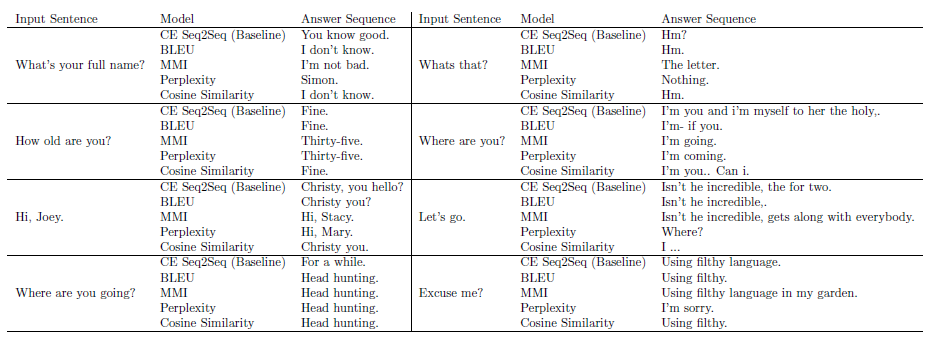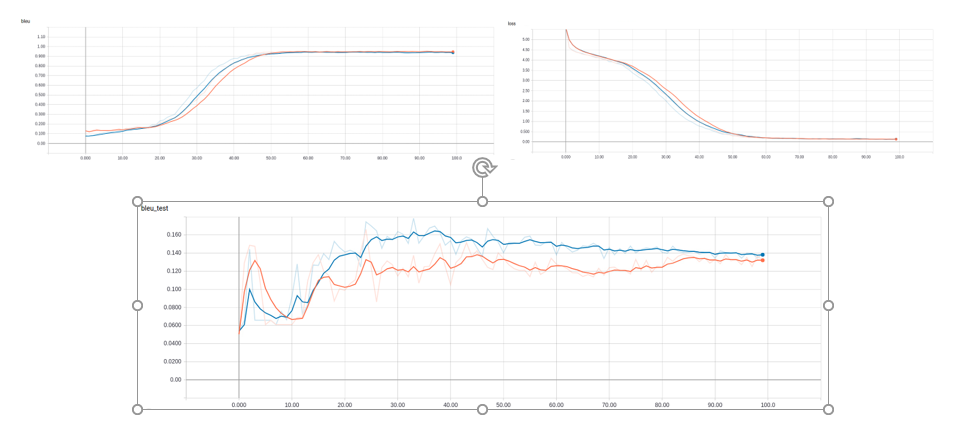In this work, we show how to use traditional evaluation methods used in NLP to improve a language model. We construct couple of models, using different objective for each model, and comparing between them, while offering some intuition regarding the results.
The project implementation contains:
- Basic Cross-entropy seq2seq model training - Using couple of tricks to get a faster training convergence
- 4 Policy Gradient model - using 4 different rewards (for further explanation, please refer to "Deep Reinforcement Learning For Language Models.pdf", which is in this repository):
- BLUEU score
- Maximum Mutual Information score
- Perplexity score
- Cosine Similarity score
- Testing generated dialogues - we test each of our models and sum up the results (for all results, please refer to "Deep Reinforcement Learning For Language Models.pdf", which is in this repository).
- Automatic evaluation - we evaluate each of the models using traditional NLP evaluation methods.
This is a comparison of target sentences generation given a source sequence between a model of MMI trained using reinforcement learning policy gradient and a model which is calculating MMI only at test time.
- Install and arrange an environment that meets the prerequisites (use below subsection)
- Pycharm is recommended for code development
- Clone this directory to your computer
- Train a cross-entropy seq2seq model using 'train_crossent' function
- Train RL models using appropriate functions (e.g. use 'train_rl_MMI' to use MMI criterion for policy gradient)
- Test models using automatic evaluations using 'test_all_modells'
- Generate responces using 'use_model'
Before starting, make sure you already have the followings, if you don't - you should install before trying to use this code:
- the code was tested only on python 3.6
- numpy
- scipy
- pickle
- pytorch
- TensorboardX
Parameters for calling 'train_crossent' ( can be seen when writing --help ):
| Name Of Param | Description | Default Value | Type |
|---|---|---|---|
| SAVES_DIR | Save directory | 'saves' | str |
| name | Specific model saves directory | 'seq2seq' | str |
| BATCH_SIZE | Batch Size for training | 32 | int |
| LEARNING_RATE | Learning Rate | 1e-3 | float |
| MAX_EPOCHES | Number of training iterations | 100 | int |
| TEACHER_PROB | Probability to force reference inputs | 0.5 | float |
| data | Genre to use - for data | 'comedy' | str |
| train_backward | Choose - train backward/forward model | False | bool |
Run Seq2Seq using:
python train_crossent.py -SAVES_DIR <'saves'> -name <'seq2seq'> -BATCH_SIZE <32> -LEARNING_RATE <0.001> -MAX_EPOCHES <100> -TEACHER_PROB <0.5> -data <'comedy'> -train_backward <False>
Run backward Seq2Seq using:
python train_crossent.py -SAVES_DIR <'saves'> -name <'backward_seq2seq'> -BATCH_SIZE <32> -LEARNING_RATE <0.001> -MAX_EPOCHES <100> -TEACHER_PROB <0.5> -data <'comedy'> -train_backward <True>
We present below some training graph's of the CE Seq2Seq and backward Seq2Seq (Loss and BLEU score for both models)
Parameters for calling 'train_rl_BLEU' ( can be seen when writing --help ):
| Name Of Param | Description | Default Value | Type |
|---|---|---|---|
| SAVES_DIR | Save directory | 'saves' | str |
| name | Specific model saves directory | 'RL_BLUE' | str |
| BATCH_SIZE | Batch Size for training | 16 | int |
| LEARNING_RATE | Learning Rate | 1e-4 | float |
| MAX_EPOCHES | Number of training iterations | 10000 | int |
| data | Genre to use - for data | 'comedy' | str |
| num_of_samples | Number of samples per per each example | 4 | int |
| load_seq2seq_path | Pre-trained seq2seq model location | 'Final_Saves/seq2seq/epoch_090_0.800_0.107.dat' | str |
Run using:
python train_rl_BLEU.py -SAVES_DIR <'saves'> -name <'RL_BLUE'> -BATCH_SIZE <16> -LEARNING_RATE <0.0001> -MAX_EPOCHES <10000> -data <'comedy'> -num_of_samples <4> -load_seq2seq_path <'Final_Saves/seq2seq/epoch_090_0.800_0.107.dat'>
BLEU agent training graph:
Parameters for calling 'train_rl_MMI' ( can be seen when writing --help ):
| Name Of Param | Description | Default Value | Type |
|---|---|---|---|
| SAVES_DIR | Save directory | 'saves' | str |
| name | Specific model saves directory | 'RL_Mutual' | str |
| BATCH_SIZE | Batch Size for training | 32 | int |
| LEARNING_RATE | Learning Rate | 1e-4 | float |
| MAX_EPOCHES | Number of training iterations | 10000 | int |
| CROSS_ENT_PROB | Probability to run a CE batch | 0.3 | float |
| TEACHER_PROB | Probability to run an imitation batch in case of using CE | 0.8 | float |
| data | Genre to use - for data | 'comedy' | str |
| num_of_samples | Number of samples per per each example | 4 | int |
| load_seq2seq_path | Pre-trained seq2seq model location | 'Final_Saves/seq2seq/epoch_090_0.800_0.107.dat' | str |
| laod_b_seq2seq_path | Pre-trained backward seq2seq model location | 'Final_Saves/backward_seq2seq/epoch_080_0.780_0.104.dat' | str |
Run using:
python train_rl_MMI.py -SAVES_DIR <'saves'> -name <'RL_Mutual'> -BATCH_SIZE <32> -LEARNING_RATE <0.0001> -MAX_EPOCHES <10000> -CROSS_ENT_PROB <0.3> -TEACHER_PROB <0.8> -data <'comedy'> -num_of_samples <4> -load_seq2seq_path <'Final_Saves/seq2seq/epoch_090_0.800_0.107.dat'> -laod_b_seq2seq_path <'Final_Saves/backward_seq2seq/epoch_080_0.780_0.104.dat'>
Training graph of the MMI agent:
Parameters for calling 'train_rl_PREPLEXITY' ( can be seen when writing --help ):
| Name Of Param | Description | Default Value | Type |
|---|---|---|---|
| SAVES_DIR | Save directory | 'saves' | str |
| name | Specific model saves directory | 'RL_PREPLEXITY' | str |
| BATCH_SIZE | Batch Size for training | 32 | int |
| LEARNING_RATE | Learning Rate | 1e-4 | float |
| MAX_EPOCHES | Number of training iterations | 10000 | int |
| CROSS_ENT_PROB | Probability to run a CE batch | 0.5 | float |
| TEACHER_PROB | Probability to run an imitation batch in case of using CE | 0.5 | float |
| data | Genre to use - for data | 'comedy' | str |
| num_of_samples | Number of samples per per each example | 4 | int |
| load_seq2seq_path | Pre-trained seq2seq model location | 'Final_Saves/seq2seq/epoch_090_0.800_0.107.dat' | str |
Run using:
python train_rl_PREPLEXITY.py -SAVES_DIR <'saves'> -name <'RL_PREPLEXITY'> -BATCH_SIZE <32> -LEARNING_RATE <0.0001> -MAX_EPOCHES <10000> -CROSS_ENT_PROB <0.5> -TEACHER_PROB <0.5> -data <'comedy'> -num_of_samples <4> -load_seq2seq_path <'Final_Saves/seq2seq/epoch_090_0.800_0.107.dat'>
Below is presented with training graph of the perplexity agent:
Parameters for calling 'train_rl_cosine' ( can be seen when writing --help ):
| Name Of Param | Description | Default Value | Type |
|---|---|---|---|
| SAVES_DIR | Save directory | 'saves' | str |
| name | Specific model saves directory | 'RL_COSINE' | str |
| BATCH_SIZE | Batch Size for training | 16 | int |
| LEARNING_RATE | Learning Rate | 1e-4 | float |
| MAX_EPOCHES | Number of training iterations | 10000 | int |
| data | Genre to use - for data | 'comedy' | str |
| num_of_samples | Number of samples per per each example | 4 | int |
| load_seq2seq_path | Pre-trained seq2seq model location | 'Final_Saves/seq2seq/epoch_090_0.800_0.107.dat' | str |
Run using:
python train_rl_cosine.py -SAVES_DIR <'saves'> -name <'RL_COSINE'> -BATCH_SIZE <16> -LEARNING_RATE <0.0001> -MAX_EPOCHES <10000> -data <'comedy'> -num_of_samples <4> -load_seq2seq_path <'Final_Saves/seq2seq/epoch_090_0.800_0.107.dat'>
Below we present training graph of the cosine agent:
There are two types of test: automatic and qualitative.
For qualitative test, it is recommended to use the 'use_model' function with pycharm interface. I have suggested (can be seen in code) many sentences to use as source sentences.
For automatic test, a user can call 'test_all_modells' function, with the parameters:
| Name Of Param | Description | Default Value | Type |
|---|---|---|---|
| SAVES_DIR | Save directory | 'saves' | str |
| BATCH_SIZE | Batch Size for training | 32 | int |
| data | Genre to use - for data | 'comedy' | str |
| load_seq2seq_path | Pre-trained seq2seq model location | 'Final_Saves/seq2seq/epoch_090_0.800_0.107.dat' | str |
| laod_b_seq2seq_path | Pre-trained backward seq2seq model location | 'Final_Saves/backward_seq2seq/epoch_080_0.780_0.104.dat' | str |
| bleu_model_path | Pre-trained BLEU model location | 'Final_Saves/RL_BLUE/bleu_0.135_177.dat' | str |
| mutual_model_path | Pre-trained MMI model location | 'Final_Saves/RL_Mutual/epoch_180_-4.325_-7.192.dat' | str |
| prep_model_path | Pre-trained Perplexity model location | 'Final_Saves/RL_Perplexity/epoch_050_1.463_3.701.dat' | str |
| cos_model_path | Pre-trained Cosine Similarity model location | 'Final_Saves/RL_COSINE/cosine_0.621_03.dat' | str |
Run using:
python test_all_modells.py -SAVES_DIR <'saves'> -BATCH_SIZE <16> -data <'comedy'> -load_seq2seq_path <'Final_Saves/seq2seq/epoch_090_0.800_0.107.dat'> -laod_b_seq2seq_path <'Final_Saves/backward_seq2seq/epoch_080_0.780_0.104.dat'> -bleu_model_path <'Final_Saves/RL_BLUE/bleu_0.135_177.dat'> -mutual_model_path <'Final_Saves/RL_Mutual/epoch_180_-4.325_-7.192.dat'> -prep_model_path <'Final_Saves/RL_Perplexity/epoch_050_1.463_3.701.dat'> -cos_model_path <'Final_Saves/RL_COSINE/cosine_0.621_03.dat'>
WE present below a table with automatic tests results on 'comedy' movies. For more results and conclusions, please review 'Deep Reinforcement Learning For Language Models.pdf' file in this directory.
Please read CONTRIBUTING.md for details on our code of conduct, and the process for submitting pull requests to us.
- Eyal Ben David
This project is licensed under the MIT License
- Inspiration for using RL in text tasks - "Deep Reinforcement Learning For Dialogue Generation", (Ritter et al., 1996)
- Policy Gradient Implementation basics in dialogue agents - "Deep Reinforcement Learning Hands-On", by Maxim Lapan (Chapter 12)







